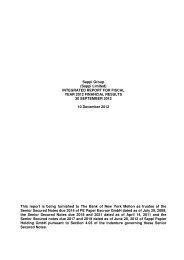2007 Annual Report - Sappi
2007 Annual Report - Sappi
2007 Annual Report - Sappi
You also want an ePaper? Increase the reach of your titles
YUMPU automatically turns print PDFs into web optimized ePapers that Google loves.
Notes to the group annual financial statements continued<br />
for the year ended September <strong>2007</strong><br />
2. Accounting policies continued<br />
transaction or service will flow to the group and the costs<br />
associated with the transaction or service can be measured<br />
reliably. Dividends receivable are included separately in dividend<br />
income, within finance income, when a dividend is declared.<br />
2.3.5 Government grants<br />
Government grants are recognised in income over the periods<br />
necessary to match them with the related costs which they are<br />
intended to compensate.<br />
Government grants related to assets are recognised by<br />
deducting the grant from the carrying amount of the<br />
related asset.<br />
2.3.6 Intangible assets<br />
• Research activities<br />
Expenditure on research activities undertaken with the<br />
prospect of gaining new scientific or technical knowledge and<br />
understanding, and expenditure on internally generated<br />
goodwill and brands are recognised in profit or loss as an<br />
expense as incurred.<br />
• Development activities<br />
Expenditure on engineering projects, computer software and<br />
other development activities, whereby set procedures and<br />
processes are applied to a project for the production of new or<br />
substantially improved products and processes, is capitalised<br />
if the engineering projects, computer software and other<br />
developed products or processes are technically and<br />
commercially feasible and the group has sufficient resources to<br />
complete development. The expenditure capitalised includes<br />
the cost of materials and directly attributable employee and<br />
other costs. Computer development expenditure is amortised<br />
only once the relevant software has been commissioned.<br />
Intangible assets are stated at cost less accumulated<br />
amortisation and impairment losses. Intangible assets, which<br />
have not yet been commissioned, are stated at cost less<br />
impairment losses.<br />
Amortisation of engineering projects, computer software and<br />
development costs is charged to profit or loss on a straight-line<br />
basis over the estimated useful lives of these assets, not<br />
exceeding five years. Subsequent expenditure relating to<br />
computer software is capitalised only when it increases the<br />
future economic benefits embodied in the specific asset to<br />
which it relates. All other subsequent expenditure is recognised<br />
as an expense in the period in which it is incurred.<br />
Surpluses or deficits on the disposal of computer software are<br />
recognised in profit or loss in the period in which they are<br />
incurred. The profit or loss is the difference between the net<br />
disposal proceeds and the carrying amount of the asset.<br />
• Patents<br />
Patents acquired are capitalised and amortised on a straight<br />
line basis over their estimated useful lives, which is on average<br />
10 years.<br />
2.3.7 Impairment of assets other than goodwill and<br />
financial instruments<br />
The group assesses all assets (other than goodwill and<br />
intangible assets not yet available for use) at each balance sheet<br />
date for indications of an impairment or the reversal of a<br />
previously recognised impairment. Should there be any<br />
indications of impairment, the recoverable amounts of the<br />
assets are estimated. These impairments, where the carrying<br />
value of an asset exceeds its recoverable amount, or the<br />
reversal of a previously recognised impairment, are recognised<br />
in profit or loss for the period.<br />
Intangible assets not yet available for use are tested at least<br />
annually for impairment.<br />
An impairment loss is recognised in profit or loss whenever the<br />
carrying amount of an asset exceeds its recoverable amount.<br />
The recoverable amount of an asset is the higher of its fair value<br />
less cost to sell and its value-in-use. The fair value less cost to<br />
sell is determined by ascertaining the current market value of an<br />
asset and deducting any costs related to the realisation of<br />
the asset.<br />
In assessing value-in-use, the expected future cash flows from<br />
the asset are discounted to their present value using a discount<br />
rate as defined on page 73.<br />
For an asset whose cash flows are largely dependent on those<br />
of other assets the recoverable amount is determined for the<br />
cash-generating unit to which the asset belongs.<br />
A previously recognised impairment loss will be reversed if<br />
the recoverable amount increases as a result of a change in<br />
the estimates used previously to determine the recoverable<br />
amount, but not to an amount higher than the carrying amount<br />
that would have been determined, net of depreciation or<br />
amortisation, had no impairment loss been recognised in<br />
prior periods.<br />
80<br />
sappi limited | 07 | annual report
















